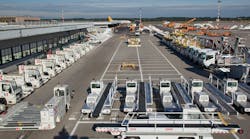Aéroports de Montréal (ADM) on July 21, announced its consolidated operating results for the three- and six-month periods ended June 30. These results are accompanied by data on passenger traffic and aircraft movements at Montréal–Trudeau and Montréal–Mirabel international airports.
Highlights
Montréal–Trudeau set new passenger records for both periods, with 4.0 million passengers enplaned/deplaned in the second quarter, an increase of 4.8 percent over the corresponding quarter a year ago, and 7.9 million passengers for the first six months ended June 30, up 4.9 percent over the same period of 2015. All three sectors – domestic, transborder (U.S.) and international – contributed to this sustained growth.
EBITDA (excess of revenues over expenses before financial expenses, income taxes, depreciation and impairment of property and equipment) totalled $62.3 million for the second quarter of 2016, a rise of $3.2 million, or 5.4 percent over the same year-ago quarter. EBITDA for the half-year ended June 30, reached $119.4 million, up $7.0 million, or 6.2 percent, against the corresponding 2015 period.
The Corporation invested a total of $56.6 million in the second quarter and $94.1 million for the first six months of 2016 (compared with $60.1 million and $89.8 million respectively in 2015). Investments in the airports were financed by cash flows from operating activities, including $78.4 million ($75.3 million net of airline collection fees) from airport improvement fees (AIFs).
Financial results
Consolidated revenues amounted to $127.2 million for the second quarter, an increase of $7.7 million, or 6.4 percent over the same 2015 quarter. Accumulated revenues as at June 30, rose by $13.8 million, or 5.8 percent, reaching $253.4 million compared with $239.6 million for the first six months of 2015. This improvement is mainly attributable to the growth of passenger traffic and higher revenues from commercial activities.
Operating costs for the quarter under review were $41.6 million, up $2.8 million, or 7.2 percent, over the corresponding 2015 period. Operating costs for the six months ended June 30, 2016, rose by $4.2 million, or 5.1 percent, to $86.8 million from $82.6 million for the same period a year earlier. This variance is due to the annual increase in salaries and certain operating expenses.
Transfers to governments (payments in lieu of municipal taxes [PILT] and rent paid to Transport Canada) reached $23.3 million for the second quarter of 2016 ($21.6 million for the 2015 period) and $47.2 million for the half-year ended June 30, ($44.6 million for the 2015 period), representing nearly 19 percent of the Corporation’s total revenues.
Depreciation of property and equipment amounted to $29.7 million for the quarter, an increase over the prior-year period of $2.6 million, or 9.6 percent. Depreciation of property and equipment for the six months ended June 30, was $58.4 million, an increase of $4.0 million, or 7.4 percent, over the corresponding half-year of 2015. This rise is attributable to the commissioning of projects completed during 2015 and of the new extension of the international jetty in May.
Financial expenses rose to $24.6 million for the quarter under review, up $2.5 million, or 11.3 percent. Cumulative financial expenses as at June 30, rose by $3.9 million, or 8.8 percent, to $48.2 million This increase is due mainly to higher financial expenses related to the issuance of Series M revenue bonds in June 2015.
The second quarter ended June 30, produced an excess of revenues over expenses of $8.0 million, compared with $9.9 million for the corresponding quarter a year earlier, a decrease of $1.9 million, or 19.2 percent. At June 30, the excess of revenues over expenses was $12.8 million, against $13.7 million for the same period of 2015.
EBITDA is a financial measurement that is not recognized by International Financial Reporting Standards (IFRS) and is therefore unlikely to be comparable to similar measures presented by other corporations. EBITDA is defined by the Corporation as the excess of revenues over expenses before financial expenses, income taxes, depreciation and impairment of property and equipment. EBITDA is used by management as an indicator to evaluate ongoing operational performance. It is meant to provide additional information and should not be considered as a substitute for other performance measurements prepared in accordance with IFRS.
Passenger traffic
Total passenger traffic at Montréal–Trudeau for the second quarter of 2016 was up by 4.8 percent, to 4.0 million passengers enplaned/deplaned. International traffic rose by 3.3 percent, domestic traffic by 7.6 percent, and transborder (U.S.) traffic by 2.8 percent over the year-earlier quarter. For the first six months of 2016, passenger traffic was up by 4,9 percent to 7.9 million passengers enplaned/deplaned.
Aircraft movements
Total aircraft movements at both ADM airports rose by 2.5 percent in the second quarter of 2016, to 60,023, against 58,585 movements for the same 2015 quarter. For the first six months of the year, movements rose by 3.2 percent to 116,263.

